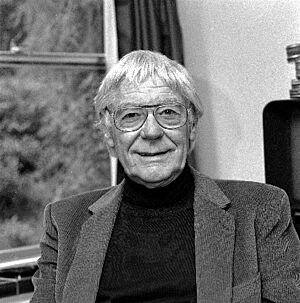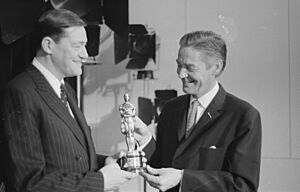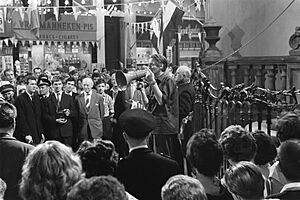Bert Haanstra facts for kids
Quick facts for kids
Bert Haanstra
|
|
|---|---|

Haanstra in 1989
|
|
| Born |
Albert Haanstra
31 May 1916 Holten, Netherlands
|
| Died | 23 October 1997 (aged 81) |
| Occupation | Photographer, cameraman, film director |
| Years active | 1948–1988 (film director) |
| Spouse(s) | Nita Wijtmans |
| Children | Rimko and Jurre |
Albert Haanstra (born May 31, 1916 – died October 23, 1997) was a famous Dutch director who made both movies and documentaries. He won an Oscar for his short documentary called Glass in 1959. His movie Fanfare (1958) was once the most-watched Dutch film ever. Only Turkish Delight (1973) later became more popular.
Contents
Early Life of Bert Haanstra
Albert Haanstra was born on May 31, 1916, in a small village called Espelo, near Holten in the Netherlands. His father, Folkert Haanstra, was a schoolteacher. His mother was Jansje Schuiveling. Bert grew up in the village of Goor. Life was tough in the 1920s, so he learned to work hard and live simply.
Bert's father stopped teaching early to follow his dream of becoming a painter. Bert also became a painter, but he soon started trying out photography. He loved it!
His interest in movies grew when he became friends with a local cinema owner. This friend let him watch movies for free from the projection room. Bert was so excited that he collected old, thrown-away equipment to build his own movie projector. He did odd jobs to earn money and bought films from a local drugstore to play them. He was even accepted into a famous art academy, but he decided that real-life experience was more important than long years of study. Later, as a press photographer, he started making his first film, Catfish.
Bert Haanstra's Film Career
Bert Haanstra became a professional Dutch documentary filmmaker in 1947. He became famous around the world with his short documentary Spiegel van Holland (Mirror of Holland). He won a big award for it at the Cannes Film Festival in 1951. In the 1950s, he made six films for Shell, including The Rival World (1955). This film was about insects spreading diseases and how to stop them.
In 1958, his documentary Glass won an Oscar. He filmed it in a glass factory, showing the beauty of how glass is made. Many of Haanstra's films had a poetic style. They made viewers see the wonder and beauty in everyday things.
Popular Movies
Haanstra also directed several fiction films. Fanfare is a comedy set in a small Dutch village. It is still the Netherlands' second most popular film ever. Only Paul Verhoeven's Turkish Delight has been seen by more people. Fanfare was shown at the 1959 Cannes Film Festival and the 1st Moscow International Film Festival.
After Fanfare, he made another short film called Zoo. It came out on December 14, 1962. This film humorously compared how animals and humans behave. Haanstra loved to try new filming techniques. In Zoo, he used hidden cameras to capture the real actions of both people and animals. In 1963, Zoo was nominated for a BAFTA Film Award for Best Short Film.
Documentaries About the Netherlands and Animals
In many short films and longer documentaries like Alleman / The Human Dutch and Stem van het water / The Voice of the Water, Haanstra showed what the Netherlands and its people were like. These films made him one of the most loved filmmakers in Dutch history. The documentary Alleman was seen in cinemas by 20% of the entire Dutch population!
In the 1970s and 1980s, Haanstra started making films about animals. In his long documentary Ape and Super-Ape (Bij de Beesten af) (1973), he worked with famous scientists like Frans de Waal and Jane Goodall. In this film, he compared the behavior of animals and humans. Bert Haanstra received almost a hundred awards in his career. He was also honored as an Officer in the Order of Orange-Nassau.
Death
Bert Haanstra passed away on October 23, 1997, at the age of 81. He died in a nursing home in Hilversum, Netherlands, from Alzheimer's disease. After he died, a special Dutch film award, which Haanstra himself had won, was renamed the Bert Haanstra Oeuvre Award in his honor.
Filmography
- De Muiderkring Herleeft (1948)
- Mirror of Holland (1950)
- Nederlandse Beeldhouwkunst tijdens de late Middeleeuwen (1951)
- Panta Rhei (1952)
- Dijkbouw (1952)
- Ontstaan en Vergaan (1954)
- De Opsporing van Aardolie (1954)
- De Verkenningsboring (1954)
- The Rival World (1955)
- En de zee was niet meer (1955)
- God Shiva (1955)
- Rembrandt, schilder van de mens (1957)
- Over glas gesproken (1958)
- Glass (1958)
- Fanfare (1958)
- The Manneken Pis Case (1960)
- Delta Phase I (1962)
- Zoo (1962)
- Lewis Mumford on the City, Part 2: The City - Cars or People? (1963)
- The Human Dutch (1963)
- The Voice of the Water (1966)
- Evoluon (1967)
- Return Ticket to Madrid (1967)
- Ape and Super-Ape (1972)
- When the Poppies Bloom Again (1975)
- Nationale Parken... Noodzaak (1978)
- Mr. Slotter's Jubilee (1979)
- Nederland (1983)
- Vroeger kon je lachen (1983)
- The Family of Chimps (1984)
- Kinderen van Ghana (1988)



